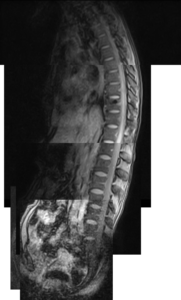Effects of sex on belt fit in relation to skeletal geometry
The goal of this study is to determine if seatbelts fit males and females differently. In order to do this, it is important to determine seatbelt location relative to external body shape, and relative to the bones with which it is designed to interact. Therefore, this study consists of two parts: 1) in-vehicle measurements of seated posture and seatbelt location in a rental vehicle, and 2) an upright MRI session, in which these seated postures and seatbelt locations will be replicated in a MRI-safe (no metal) vehicle seat setup.

Why should you participate in this study?
You will be able to obtain copies of your scans, if desired. You may also receive feedback on your seatbelt fit and suggestions for ways in which they could improve their fit relative to your skeletal system, if desired. This feedback will be determined by a panel of automotive safety and injury biomechanics researchers. However, there may not be direct benefit to you from taking part in this study.
You may be eligible to participate in this study if you:
- are healthy and uninjured
- are between the ages of 19 and 60 years old
If any of the following are true, you are ineligible to participate in this study. You:
- have claustrophobia
- have a cardiac pacemaker, wires, or defibrillator
- have metal in your eye or orbit
- have a ferromagnetic aneurysm clip
- may be or are pregnant.
Depending upon the individual situation, you might be ineligible to participate if you have any of the following:
- artificial heart valve
- ear or eye implant
- brain aneurysm clip
- implanted drug infusion pump
- electrical stimulator for nerves or bones
- coil, catheter, or filter in any blood vessel
- orthopaedic hardware (artificial joint, plate, screw, rod)
- other metallic prostheses
- shrapnel, bullets, or other metal fragments
- surgery or tattoos (including tattooed eyeliner) in the last six weeks.
If you have any of the above, your individual case will be reviewed by the hospital MR Technologist and/or Radiologist.
Time commitment
2-3 hour initial session and 5 hour MRI session
This study will take place at:
- ICORD/Blusson Spinal Cord Centre (818 West 10th Avenue, Vancouver)
- MEA Forensic (Richmond) and Jim Pattison Pavilion on the VGH campus
For more information or to sign up to participate, please contact the study coordinator, Paris Vakiel, by email at Paris.vakiel@ubc.ca or phone at 604 822-6629.

